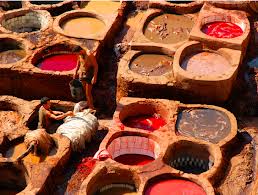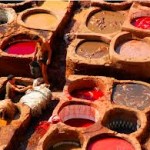Worldcrunch
The tanneries of Fez – (Indo_Girl 2010)
LE MONDE/Worldcrunch
FEZ – Everyone should go to the Moroccan city of Fez at least once, if only to get lost in the medina, around the mosque of al-Karaouine, the oldest university in the world.
You could choose to spend the hot hours of the day in the Bou Inania Madrasa, the religious school built in the 14th century; or in the Al-Attarine Madrasa — the most beautiful one, according to Moroccans, with its walls covered with sutras sculpted in wood and plaster.
You also should not miss the chance to contemplate the mausoleum of Moulay Idriss, the city’s founder, located between Nejjarine square and the Attarine souk, and then to walk through some of the thousands of narrow streets, before the city once known as “the Athens of Africa” disappears or becomes just a neighborhood lost in a bigger metropolis.
Twelve centuries after the former capital of Morocco was created in 789, the imperial city “is in a state of advanced deterioration, when it comes to both its infrastructure -including the state of sanitation, roads, street lighting- and its housing. Half of what was built is now degraded,” economist Naima Lahbil Tagemouati wrote in the journal Patrimoines en situation (Living Heritage) in 2001.
More than 30 years have passed since Amadou M’Bow’s speech in April 1980, in which UNESCO’s director-general vowed to safeguard “one of the most prestigious cities of the Islamic world.” Today the situation remains critical, threatening more than a thousand years of history and endangering what is left of the Spanish-Arabic culture and civilization.
“Fez must be saved for its people, for Morocco, the Islamic world and the entire international community, because it belongs to the common heritage of mankind”, M’Bow said at the time.
Tremendous efforts were made, partly funded by the Moroccan authorities with the help of UNESCO – the site was declared World Heritage in 1981 – and partly by foreign investors.
Renovating, rethinking, rehabilitating
The most polluting activities (tanners, coppersmiths working with copper or tin) were removed from the medina and installed in a new artisan district, in the Ain Noqbi neighborhood, outside the walls of the medina.
The most prestigious monuments and sites are currently being renovated. Road traffic inside the medina is going to be rerouted to facilitate the comings and goings of the 900 or so donkeys and mules that carry timber and other goods around the city every day. The entire water supply and wastewater infrastructure is far from sufficient. A new wastewater treatment plant has been built downstream from the city in order to improve the situation and should be up and running by the end of the year.
The urban renewal, which is expected to significantly alter the medina, is not what tourists notice when they come to Fez for the first time. They fall in love with the souks and their narrow stalls piled with tons of objects, fabrics, and all kinds of colorful products. They shoulder their way through funduqs, former caravanserais (roadside inns) turned into museums. They fall under the charm of palaces and of dwellings built almost on top of each other like a house of cards. Tourists wander, gazing all around, in this colorful labyrinth, this huge teeming open-air market, home to more than 100,000 people. Nearly 40,000 artisans still work there.
There are only three traditional tanneries left in the medina. The most famous one, the Chouara, located behind the medina, is open to the public every day except Friday. From its upper terraces, you can see barelegged men standing in huge vats, dyeing, cleaning, and rinsing sheep, goat, cow and camel skins.
You must leave the medina now to find the potters’ district, which was moved a few miles down the road to Taza because of the black smoke of its furnaces and fires. Blacksmiths and tinsmiths, too, have been relocated outside the old city because of pollution.
“Coppersmiths who still use handheld hammers were allowed to stay, but those who use polishing machines, for example, were kicked out,” says Chakib Kabbaj, President of the Fez Guides Association. “The same thing will happen soon with the old oil-presses.”
The clock is ticking, as some traditional crafts are on the verge of extinction. “There are only two horn-comb-makers left in the medina,” laments Kabbaj. “And only one who knows how to make wooden juniper buckets, like the ones we use in hammams.”
Read the article in the original language.
Photo by – Indo_Girl 2010
Published on 2012-10-24 16:35:18
.








